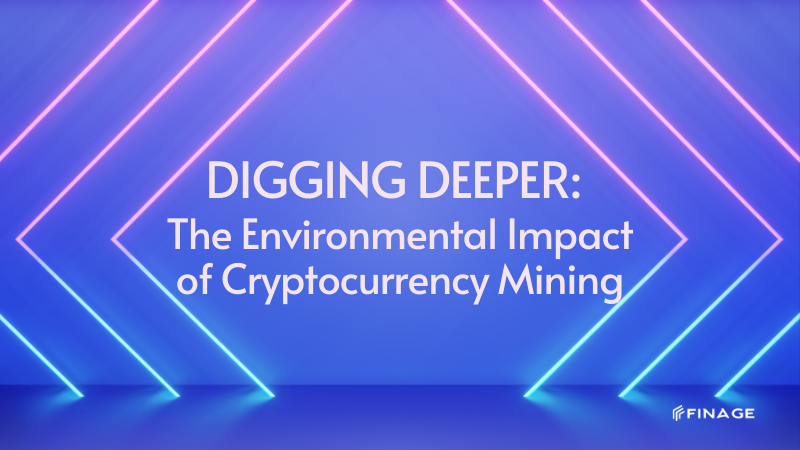Digging Deeper: The Environmental Impact of Cryptocurrency Mining
4 min read • August 9, 2023

Introduction
Table of Contents
- Introduction
- Understanding Cryptocurrency Mining
- Energy Consumption
- Education and Advocacy
- Incentivizing Green Practices
- Community-Led Initiatives
- Technological Innovations
- Carbon Offsetting
- Conclusion
In the age of digitization, cryptocurrencies have emerged as a revolutionary force in the financial world. However, the rise of these digital currencies, particularly through the process of mining, has raised concerns about their environmental impact. In this blog post, we'll delve into the environmental ramifications of cryptocurrency mining and explore potential solutions for a more sustainable future.
Understanding Cryptocurrency Mining:
Cryptocurrency mining is the process by which new coins are created and transactions are added to the blockchain. This process involves solving complex mathematical problems, typically through a computer's powerful processing units. While this method ensures the security and integrity of the decentralized blockchain, it comes at a considerable cost to the environment.
Energy Consumption:
One of the primary environmental concerns associated with cryptocurrency mining is its significant energy consumption. Bitcoin, the pioneering cryptocurrency, relies on a proof-of-work consensus algorithm, which demands an enormous amount of computational power. As a result, mining operations worldwide consume vast quantities of electricity, often sourced from non-renewable fossil fuels.
Carbon Footprint:
The carbon footprint of cryptocurrency mining is a pressing issue. Many mining operations are located in regions where electricity is cheap, often due to the use of coal or other fossil fuels. The combustion of these fuels releases greenhouse gases into the atmosphere, contributing to climate change. As the cryptocurrency market expands, so does its carbon footprint, intensifying environmental concerns.
E-Waste:
In addition to energy consumption, the rapid turnover of mining hardware contributes to electronic waste (e-waste) concerns. Mining rigs have a relatively short lifespan due to the continuous advancement of technology. Discarded hardware, which often contains hazardous materials, poses environmental risks if not properly disposed of or recycled.
Sustainable Solutions:
Transition to Proof-of-Stake: Some cryptocurrencies are exploring or have already implemented a proof-of-stake consensus algorithm as an alternative to proof-of-work. Proof-of-stake relies on validators who lock up a certain amount of cryptocurrency as collateral, reducing the need for extensive computational power and energy consumption.
Renewable Energy Sources: Encouraging mining operations to transition to renewable energy sources, such as solar or wind power, can significantly mitigate the environmental impact of cryptocurrency mining. Some projects are already taking steps in this direction, setting an example for the industry.
Education and Advocacy: Increasing awareness about the environmental impact of cryptocurrency mining can drive community support for more sustainable practices. By educating miners and enthusiasts alike, we can foster a sense of responsibility and encourage the adoption of eco-friendly alternatives.
Incentivizing Green Practices: Governments and regulatory bodies can play a crucial role in promoting environmentally friendly cryptocurrency mining practices. Providing incentives, tax breaks, or subsidies for mining operations that use renewable energy sources could encourage a shift toward sustainability.
Community-Led Initiatives: Grassroots movements within the cryptocurrency community can also drive change. Developers, miners, and enthusiasts can collaborate on initiatives that prioritize eco-friendly practices, such as creating platforms that exclusively support cryptocurrencies using proof-of-stake or organizing events to raise awareness about the environmental impact of mining.
Technological Innovations: Continued research and development in blockchain technology can lead to innovations that reduce the environmental impact of cryptocurrency mining. This could involve the creation of more energy-efficient algorithms, the development of low-power mining hardware, or the integration of emerging technologies like quantum computing.
Carbon Offsetting: Cryptocurrency projects and mining operations can explore partnerships with carbon offset organizations. By investing in projects that aim to reduce or capture greenhouse gas emissions, the cryptocurrency industry can take steps to neutralize its environmental impact.
It's crucial to recognize that the environmental impact of cryptocurrency mining is a complex issue with no one-size-fits-all solution. A multifaceted approach, involving collaboration between industry stakeholders, policymakers, and the broader community, is necessary to address the challenges at hand.
Conclusion
The environmental impact of cryptocurrency mining underscores the need for responsible and sustainable practices within the industry. While the allure of decentralized digital currencies is undeniable, it is essential to strike a balance that minimizes the ecological footprint. By embracing innovation, education, and a commitment to green initiatives, the cryptocurrency community can pave the way for a more environmentally conscious future. As we navigate this evolving landscape, the choices we make today will shape the environmental legacy of tomorrow's digital economy.
You can get your Real-Time and Historical Cryptocurrency Data with a free Crypto Data API key.
Build with us today!
Claim Your Free API Key Today
Access stock, forex and crypto market data with a free API key—no credit card required.

Stay Informed, Stay Ahead
Finage Blog: Data-Driven Insights & Ideas
Discover company news, announcements, updates, guides and more


